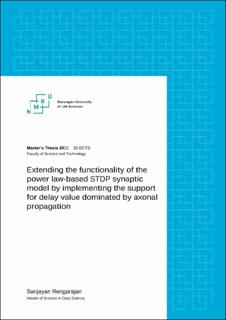| dc.contributor.advisor | Plesser, Hans Ekkehard | |
| dc.contributor.advisor | Kunkel, Susanne | |
| dc.contributor.author | Rengarajan, Sanjayan | |
| dc.date.accessioned | 2023-03-16T13:37:20Z | |
| dc.date.available | 2023-03-16T13:37:20Z | |
| dc.date.issued | 2022 | |
| dc.identifier.uri | https://hdl.handle.net/11250/3058842 | |
| dc.description.abstract | Learning is conceptualized to be possible due to the reconfiguration of neural networks in the brain. This ability is referred to as neuroplasticity. One of the ways by which plasticity is observed can be explained by plasticity exhibited by the synaptic connections between two neurons. Spike-timing-dependent plasticity (STDP) is a biological process, which has been experimentally observed to produce the effect of synaptic plasticity. The STDP process is based on the precise arrival times of presynaptic and postsynaptic spikes at the synapse. This arrival time can be calculated using the timing of the spike offset by propagation delay to the synapse from the neuron. The STDP process is known to affect the connection strength between the neurons, affecting the amplitude of the spike generated in the postsynaptic neuron.
In this thesis, we worked on the simulation model of synapses exhibiting STDP properties. We used the NEST simulator framework for the implementation. The current state-of-the-art model of the STDP synapse supports only delay values as purely dendritic. We implemented support for axonal propagation delay in the synaptic model, along with support for axonal delay value greater than dendritic delay. We verified the implementation with an independent program for testing. The implementation was then analyzed for its impact in a network with different values for the axonal delay. This was done by taking the histogram of the weights of the STDP synapse model in a many-to-one network configuration which was simulated for hundred biological seconds. The results of the analysis matched theoretical predictions with the weights shifting to a higher value as the axonal delay value was increased. The analysis was also computed after optimizing the alpha parameter of the model, to make sure the network average firing rate is at a biologically comparable level at 10 spikes/s or below. In this result, we can not see any significant shifts in weight as predicted by theory. We also benchmarked the newer algorithm to check if it has any additional computation cost, which showed our implementation did not affect the performance. | en_US |
| dc.language.iso | eng | en_US |
| dc.publisher | Norwegian University of Life Sciences, Ås | en_US |
| dc.rights | Navngivelse 4.0 Internasjonal | * |
| dc.rights.uri | http://creativecommons.org/licenses/by/4.0/deed.no | * |
| dc.title | Extending the functionality of the power law-based STDP synaptic model by implementing the support for delay value dominated by axonal propagation | en_US |
| dc.type | Master thesis | en_US |
| dc.description.localcode | M-DV | en_US |

